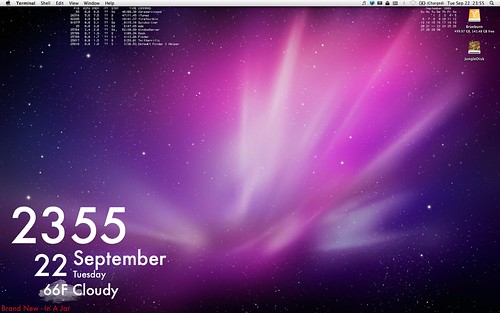UPDATE: It seems that Yahoo! has changed their weather URL formats, which breaks the script that fetches the weather image. In order to fix it, go to Yahoo! Weather and enter your desired location. Once you have the correct page loaded, replace the URL in the script with this new one. The script should start working again.
There’s no question that my post that describes my script to get the current weather conditions with Python and Yahoo! weather feeds is the most popular post on my site. It drives a huge proportion of the (small amount of) traffic that this site gets, and the post has many more comments than the average post.
Many people post images of their desktops in their best GeekTool getup, including ones that feature my weather script. One of these in particular had a lovely image to go along with his weather conditions. The author, Gato’s, was kind enough to share how he retrieved and displayed this image in the comments of the photo post. I love this idea, and tweaked Gato’s’ method. I thought I’d detail what I did in case anyone else is interested.

Gato’s’ method of retrieving Yahoo!’s weather images involves two additional GeekTool entries: one to fetch the image, and one to display the image on the desktop. I knew that there was a better way to do this, and I knew it involved launchd. launchd is a system-wide service for starting and stopping daemons. It replaced init, cron, and many other utilities in OS X 10.4. You can find out a lot more on the previous link and on the Wikipedia page.
I had never used launchd before, but setting up my own entry was fairly straightforward after I read a couple of the related man pages. In particular, launchd.plist and execvp were very useful. In order to get started, you need to use the Property List Editor, found in /Developer/Applications/Utilities/Property List Editor.app. If you do not have Apple’s developer tools installed, you can create an XML file with a .plist extension with the same contents.
Before we start creating a launchd item, we need the script for the item to run. I have provided a bash script version of Gato’s’ image-grabbing command. I added a fifteen second timeout argument to the initial curl call; this prevents long timeouts for those times that you are without a network connection. You will also need to replace the URL at the end of line three of the script with your weather forecast URL. Simply go to the Yahoo! weather page and put in your zip or location code in order to retrieve your weather page, then paste that page’s URL into the script. You can download the script here.
1 2 3 4 5 6 | |
Now we can create the property list that will launch our image-grabbing script. launchd works by parsing a particular format of property list file. The man page for launchd.plist is very extensive and contains documentation on the entries that are allowed in a launchd item. If that is all a bit too dense, I will walk through the creation of a simple launchd item with the bare minimum of properties needed to launch our script.
Open Property List Editor.app and create a new item by clicking Add Item in the toolbar. In the Key column, type Label. The default Type is string, so type a label identifier in the Value column. I used com.thomasupton.fetchweatherimage. You can use whatever you like. Next, add another item and this time switch its Type to boolean. Type KeepAlive as the Key and don’t check the check box to leave its value as false. Add another number item called StartInterval and give it a value of 600. Finally, add an array item called ProgramArguments. Add a child to this array (just click the Add Item button with the Program Arguments node selected) and give it a value of /bin/bash. Add a second child and give it a value of /absolute/path/to/script/get_weather_image.sh, with the absolute path to where you saved the script. I have pasted the XML contents of the file here, and you can download the property list file here. You can open the property list with a text editor to edit the contents if you do not have the Property List Editor installed.
1 2 3 4 5 6 7 8 9 10 11 12 13 14 15 16 17 18 | |
What we have just created is a launchd item that will only start on demand every 600 seconds and run our script to grab the weather image. Save the property list to ~/Library/LaunchAgents and give it a name like com.thomasupton.fetchweatherimage.plist. Open Terminal.app and type the following command to load our new launchd item, replacing the name of the script with the file name that you saved your property list as.
$ launchctl load ~/Library/LaunchAgents/com.thomasupton.fetchweatherimage.plist
Back in GeekTool, all you need to do is add one new entry. Make it a picture and give it the URL file:///tmp/weather.png. Et voilà, you have a beautiful image of your weather conditions on your desktop.
I took a picture of my current desktop to show you what it looks like. I gave the weather image an opacity of 60% for a more subtle effect.
